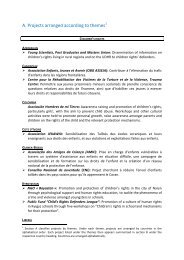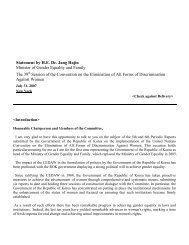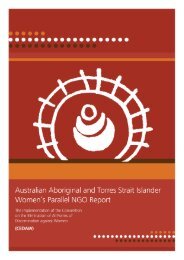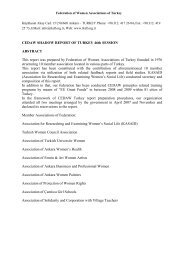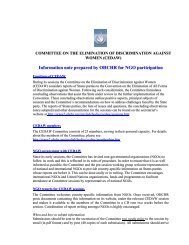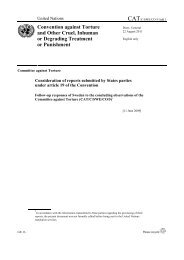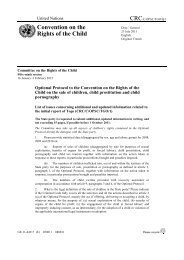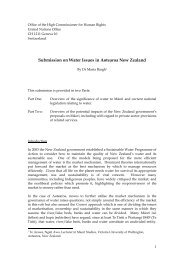Report - Office of the High Commissioner on Human Rights
Report - Office of the High Commissioner on Human Rights
Report - Office of the High Commissioner on Human Rights
- No tags were found...
You also want an ePaper? Increase the reach of your titles
YUMPU automatically turns print PDFs into web optimized ePapers that Google loves.
Gender Differences:<br />
Comm<strong>on</strong> heritage humankind<br />
Gender N<strong>on</strong>-Discriminati<strong>on</strong><br />
and Equality in <str<strong>on</strong>g>the</str<strong>on</strong>g> Right to<br />
Adequate Housing<br />
What gender differences are ‘natural’<br />
What gender differences are ‘culturally c<strong>on</strong>structed’<br />
Which group <str<strong>on</strong>g>of</str<strong>on</strong>g> differences is <str<strong>on</strong>g>the</str<strong>on</strong>g> larger<br />
Socially c<strong>on</strong>structed differences are dynamic<br />
– They can vary across cultures and time<br />
– They can change<br />
The ideology <str<strong>on</strong>g>of</str<strong>on</strong>g> gender makes socially c<strong>on</strong>structed differences<br />
seem ‘natural’ and <str<strong>on</strong>g>the</str<strong>on</strong>g>refore unchangeable<br />
The ideology <str<strong>on</strong>g>of</str<strong>on</strong>g> gender manifests in gender roles; gender<br />
relati<strong>on</strong>s; and gender identity<br />
Are differences between<br />
women and men a problem<br />
Comm<strong>on</strong> language <str<strong>on</strong>g>of</str<strong>on</strong>g> human rights:<br />
What models <str<strong>on</strong>g>of</str<strong>on</strong>g> equality are <str<strong>on</strong>g>the</str<strong>on</strong>g>re<br />
Difference is not itself a problem<br />
Difference <strong>on</strong>ly becomes a problem when it justifies<br />
discriminati<strong>on</strong> that results in:<br />
– Unequal power<br />
– Unequal opportunities<br />
– Unequal resources<br />
– Unequal resp<strong>on</strong>sibilities<br />
– Unequal rights<br />
Gender differences have historically provided <str<strong>on</strong>g>the</str<strong>on</strong>g> justificati<strong>on</strong><br />
(gender ideology) for discriminati<strong>on</strong> against women and women’s<br />
inequality<br />
<br />
<br />
<br />
<br />
<br />
<br />
<br />
Formal/sameness model:<br />
– Women enjoy <str<strong>on</strong>g>the</str<strong>on</strong>g> same rights as men – laws appear<br />
neutral as to sex/gender<br />
Protecti<strong>on</strong>ist model:<br />
– Women’s rights are restricted or formulated differently<br />
from men’s to protect women from harm because <str<strong>on</strong>g>the</str<strong>on</strong>g>y are<br />
vulnerable<br />
Substantive/Corrective model:<br />
– C<strong>on</strong>cerned with producing women’s equality in result<br />
Framing rights so <str<strong>on</strong>g>the</str<strong>on</strong>g>y are inclusive <str<strong>on</strong>g>of</str<strong>on</strong>g> women<br />
Recognizing rights that are specific to women<br />
Taking affirmative acti<strong>on</strong> measures<br />
Providing enabling c<strong>on</strong>diti<strong>on</strong>s – creating a level playing field<br />
What are <str<strong>on</strong>g>the</str<strong>on</strong>g> limitati<strong>on</strong>s <str<strong>on</strong>g>of</str<strong>on</strong>g><br />
<str<strong>on</strong>g>the</str<strong>on</strong>g>se different models<br />
Formal/sameness model – neutral laws:<br />
– Draws from male standards/experience<br />
– Women’s different experience/needs are ignored<br />
– Women may no be able to exercise <str<strong>on</strong>g>the</str<strong>on</strong>g>ir rights because<br />
• It may expose <str<strong>on</strong>g>the</str<strong>on</strong>g>m to violence/hostility<br />
• They cannot access <str<strong>on</strong>g>the</str<strong>on</strong>g> opportunities<br />
• The opportunities c<strong>on</strong>flict with <str<strong>on</strong>g>the</str<strong>on</strong>g>ir o<str<strong>on</strong>g>the</str<strong>on</strong>g>r resp<strong>on</strong>sibilities<br />
• The failure <str<strong>on</strong>g>of</str<strong>on</strong>g> women to exercise <str<strong>on</strong>g>the</str<strong>on</strong>g>ir formal equality is <str<strong>on</strong>g>of</str<strong>on</strong>g>ten<br />
interpreted as women making a choice, or as women being<br />
incapable – how could you resp<strong>on</strong>d<br />
• While essential, formal equality is not enough because it does<br />
not recognize women’s difference<br />
What are <str<strong>on</strong>g>the</str<strong>on</strong>g> limitati<strong>on</strong>s <str<strong>on</strong>g>of</str<strong>on</strong>g> <str<strong>on</strong>g>the</str<strong>on</strong>g>se<br />
different models<br />
Protecti<strong>on</strong>ist model:<br />
– Women are denied choice and aut<strong>on</strong>omy<br />
– Women are denied opportunities to develop<br />
– Stereotypes about women’s vulnerability and dependence are<br />
perpetuated<br />
• The justificati<strong>on</strong> for adopting a protecti<strong>on</strong>ist approach is <str<strong>on</strong>g>of</str<strong>on</strong>g>ten<br />
that it is in <str<strong>on</strong>g>the</str<strong>on</strong>g> best interests <str<strong>on</strong>g>of</str<strong>on</strong>g> women – how could you<br />
resp<strong>on</strong>d<br />
• While this approach recognises women’s difference,<br />
it reinforces stereotypes that perpetuate women’s inequality,<br />
<str<strong>on</strong>g>the</str<strong>on</strong>g>refore does not lead to social change<br />
What are <str<strong>on</strong>g>the</str<strong>on</strong>g> limitati<strong>on</strong>s <str<strong>on</strong>g>of</str<strong>on</strong>g><br />
<str<strong>on</strong>g>the</str<strong>on</strong>g>se different models<br />
Substantive/corrective model:<br />
– Few, if any, any limitati<strong>on</strong>s<br />
• What are <str<strong>on</strong>g>the</str<strong>on</strong>g> positive features <str<strong>on</strong>g>of</str<strong>on</strong>g> this model<br />
– The standard <str<strong>on</strong>g>of</str<strong>on</strong>g> equality is inclusive <str<strong>on</strong>g>of</str<strong>on</strong>g> women’s experience<br />
– Measures necessary to make up for women’s historical<br />
disadvantage are introduced<br />
– Background impediments are addressed<br />
• One type <str<strong>on</strong>g>of</str<strong>on</strong>g> negative resp<strong>on</strong>se to this model is that it gives women<br />
unfair advantages; ano<str<strong>on</strong>g>the</str<strong>on</strong>g>r is that it involves extra costs–how could<br />
you resp<strong>on</strong>d<br />
• This approach takes account <str<strong>on</strong>g>of</str<strong>on</strong>g> women’s differences in an<br />
empowering way that is c<strong>on</strong>sistent with equality<br />
The right to adequate housing in<br />
<str<strong>on</strong>g>the</str<strong>on</strong>g> ICESCR<br />
What model <str<strong>on</strong>g>of</str<strong>on</strong>g> equality is adopted in this<br />
article<br />
• Article 11(1): The States Parties to <str<strong>on</strong>g>the</str<strong>on</strong>g><br />
present Covenant recognize <str<strong>on</strong>g>the</str<strong>on</strong>g> right <str<strong>on</strong>g>of</str<strong>on</strong>g><br />
every<strong>on</strong>e to an adequate standard <str<strong>on</strong>g>of</str<strong>on</strong>g> living<br />
for himself and his family, including<br />
adequate food, clothing and housing, and<br />
to <str<strong>on</strong>g>the</str<strong>on</strong>g> c<strong>on</strong>tinuous improvement <str<strong>on</strong>g>of</str<strong>on</strong>g> living<br />
c<strong>on</strong>diti<strong>on</strong>s.<br />
78 WOMEN’S RIGHTS TO ADEQUATE HOUSEING AND LAND




